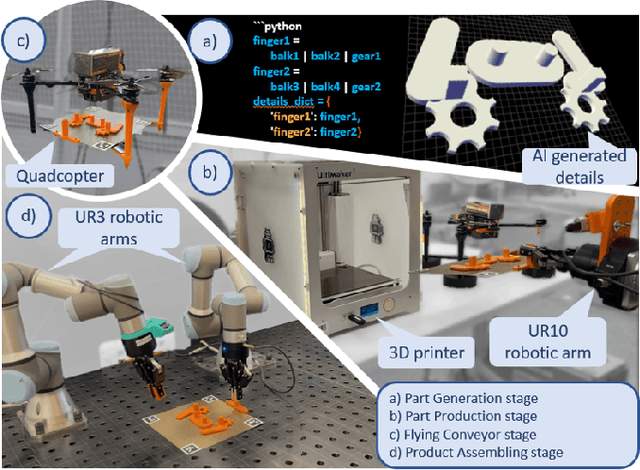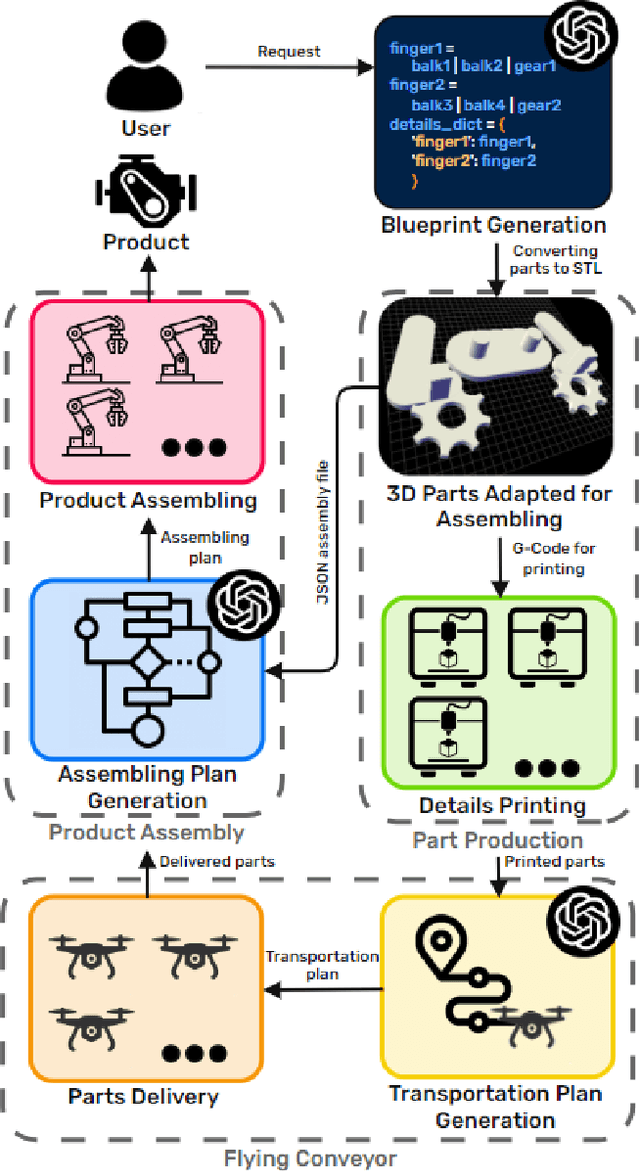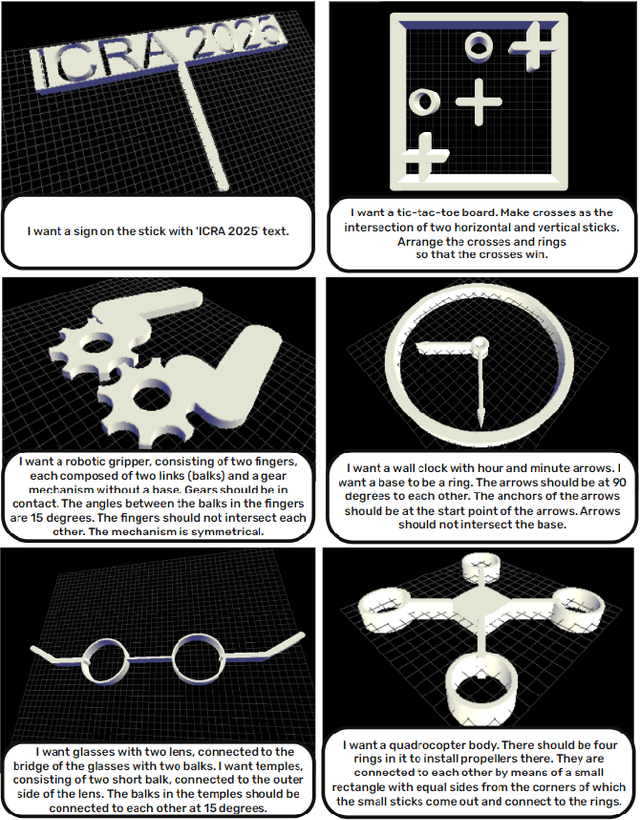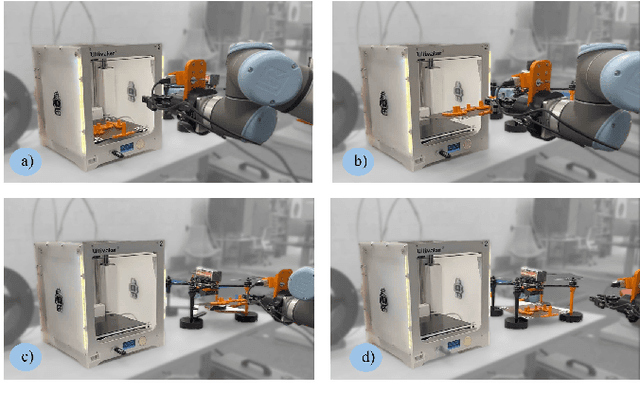Miguel Altamirano Cabrera
FlightDiffusion: Revolutionising Autonomous Drone Training with Diffusion Models Generating FPV Video
Sep 19, 2025Abstract:We present FlightDiffusion, a diffusion-model-based framework for training autonomous drones from first-person view (FPV) video. Our model generates realistic video sequences from a single frame, enriched with corresponding action spaces to enable reasoning-driven navigation in dynamic environments. Beyond direct policy learning, FlightDiffusion leverages its generative capabilities to synthesize diverse FPV trajectories and state-action pairs, facilitating the creation of large-scale training datasets without the high cost of real-world data collection. Our evaluation demonstrates that the generated trajectories are physically plausible and executable, with a mean position error of 0.25 m (RMSE 0.28 m) and a mean orientation error of 0.19 rad (RMSE 0.24 rad). This approach enables improved policy learning and dataset scalability, leading to superior performance in downstream navigation tasks. Results in simulated environments highlight enhanced robustness, smoother trajectory planning, and adaptability to unseen conditions. An ANOVA revealed no statistically significant difference between performance in simulation and reality (F(1, 16) = 0.394, p = 0.541), with success rates of M = 0.628 (SD = 0.162) and M = 0.617 (SD = 0.177), respectively, indicating strong sim-to-real transfer. The generated datasets provide a valuable resource for future UAV research. This work introduces diffusion-based reasoning as a promising paradigm for unifying navigation, action generation, and data synthesis in aerial robotics.
PhysicalAgent: Towards General Cognitive Robotics with Foundation World Models
Sep 17, 2025



Abstract:We introduce PhysicalAgent, an agentic framework for robotic manipulation that integrates iterative reasoning, diffusion-based video generation, and closed-loop execution. Given a textual instruction, our method generates short video demonstrations of candidate trajectories, executes them on the robot, and iteratively re-plans in response to failures. This approach enables robust recovery from execution errors. We evaluate PhysicalAgent across multiple perceptual modalities (egocentric, third-person, and simulated) and robotic embodiments (bimanual UR3, Unitree G1 humanoid, simulated GR1), comparing against state-of-the-art task-specific baselines. Experiments demonstrate that our method consistently outperforms prior approaches, achieving up to 83% success on human-familiar tasks. Physical trials reveal that first-attempt success is limited (20-30%), yet iterative correction increases overall success to 80% across platforms. These results highlight the potential of video-based generative reasoning for general-purpose robotic manipulation and underscore the importance of iterative execution for recovering from initial failures. Our framework paves the way for scalable, adaptable, and robust robot control.
HapticVLM: VLM-Driven Texture Recognition Aimed at Intelligent Haptic Interaction
May 05, 2025Abstract:This paper introduces HapticVLM, a novel multimodal system that integrates vision-language reasoning with deep convolutional networks to enable real-time haptic feedback. HapticVLM leverages a ConvNeXt-based material recognition module to generate robust visual embeddings for accurate identification of object materials, while a state-of-the-art Vision-Language Model (Qwen2-VL-2B-Instruct) infers ambient temperature from environmental cues. The system synthesizes tactile sensations by delivering vibrotactile feedback through speakers and thermal cues via a Peltier module, thereby bridging the gap between visual perception and tactile experience. Experimental evaluations demonstrate an average recognition accuracy of 84.67% across five distinct auditory-tactile patterns and a temperature estimation accuracy of 86.7% based on a tolerance-based evaluation method with an 8{\deg}C margin of error across 15 scenarios. Although promising, the current study is limited by the use of a small set of prominent patterns and a modest participant pool. Future work will focus on expanding the range of tactile patterns and increasing user studies to further refine and validate the system's performance. Overall, HapticVLM presents a significant step toward context-aware, multimodal haptic interaction with potential applications in virtual reality, and assistive technologies.
Evolution 6.0: Evolving Robotic Capabilities Through Generative Design
Feb 25, 2025Abstract:We propose a new concept, Evolution 6.0, which represents the evolution of robotics driven by Generative AI. When a robot lacks the necessary tools to accomplish a task requested by a human, it autonomously designs the required instruments and learns how to use them to achieve the goal. Evolution 6.0 is an autonomous robotic system powered by Vision-Language Models (VLMs), Vision-Language Action (VLA) models, and Text-to-3D generative models for tool design and task execution. The system comprises two key modules: the Tool Generation Module, which fabricates task-specific tools from visual and textual data, and the Action Generation Module, which converts natural language instructions into robotic actions. It integrates QwenVLM for environmental understanding, OpenVLA for task execution, and Llama-Mesh for 3D tool generation. Evaluation results demonstrate a 90% success rate for tool generation with a 10-second inference time, and action generation achieving 83.5% in physical and visual generalization, 70% in motion generalization, and 37% in semantic generalization. Future improvements will focus on bimanual manipulation, expanded task capabilities, and enhanced environmental interpretation to improve real-world adaptability.
GazeGrasp: DNN-Driven Robotic Grasping with Wearable Eye-Gaze Interface
Jan 14, 2025



Abstract:We present GazeGrasp, a gaze-based manipulation system enabling individuals with motor impairments to control collaborative robots using eye-gaze. The system employs an ESP32 CAM for eye tracking, MediaPipe for gaze detection, and YOLOv8 for object localization, integrated with a Universal Robot UR10 for manipulation tasks. After user-specific calibration, the system allows intuitive object selection with a magnetic snapping effect and robot control via eye gestures. Experimental evaluation involving 13 participants demonstrated that the magnetic snapping effect significantly reduced gaze alignment time, improving task efficiency by 31%. GazeGrasp provides a robust, hands-free interface for assistive robotics, enhancing accessibility and autonomy for users.
Shake-VLA: Vision-Language-Action Model-Based System for Bimanual Robotic Manipulations and Liquid Mixing
Jan 12, 2025


Abstract:This paper introduces Shake-VLA, a Vision-Language-Action (VLA) model-based system designed to enable bimanual robotic manipulation for automated cocktail preparation. The system integrates a vision module for detecting ingredient bottles and reading labels, a speech-to-text module for interpreting user commands, and a language model to generate task-specific robotic instructions. Force Torque (FT) sensors are employed to precisely measure the quantity of liquid poured, ensuring accuracy in ingredient proportions during the mixing process. The system architecture includes a Retrieval-Augmented Generation (RAG) module for accessing and adapting recipes, an anomaly detection mechanism to address ingredient availability issues, and bimanual robotic arms for dexterous manipulation. Experimental evaluations demonstrated a high success rate across system components, with the speech-to-text module achieving a 93% success rate in noisy environments, the vision module attaining a 91% success rate in object and label detection in cluttered environment, the anomaly module successfully identified 95% of discrepancies between detected ingredients and recipe requirements, and the system achieved an overall success rate of 100% in preparing cocktails, from recipe formulation to action generation.
UAV-VLA: Vision-Language-Action System for Large Scale Aerial Mission Generation
Jan 09, 2025



Abstract:The UAV-VLA (Visual-Language-Action) system is a tool designed to facilitate communication with aerial robots. By integrating satellite imagery processing with the Visual Language Model (VLM) and the powerful capabilities of GPT, UAV-VLA enables users to generate general flight paths-and-action plans through simple text requests. This system leverages the rich contextual information provided by satellite images, allowing for enhanced decision-making and mission planning. The combination of visual analysis by VLM and natural language processing by GPT can provide the user with the path-and-action set, making aerial operations more efficient and accessible. The newly developed method showed the difference in the length of the created trajectory in 22% and the mean error in finding the objects of interest on a map in 34.22 m by Euclidean distance in the K-Nearest Neighbors (KNN) approach.
TiltXter: CNN-based Electro-tactile Rendering of Tilt Angle for Telemanipulation of Pasteur Pipettes
Sep 24, 2024Abstract:The shape of deformable objects can change drastically during grasping by robotic grippers, causing an ambiguous perception of their alignment and hence resulting in errors in robot positioning and telemanipulation. Rendering clear tactile patterns is fundamental to increasing users' precision and dexterity through tactile haptic feedback during telemanipulation. Therefore, different methods have to be studied to decode the sensors' data into haptic stimuli. This work presents a telemanipulation system for plastic pipettes that consists of a Force Dimension Omega.7 haptic interface endowed with two electro-stimulation arrays and two tactile sensor arrays embedded in the 2-finger Robotiq gripper. We propose a novel approach based on convolutional neural networks (CNN) to detect the tilt of deformable objects. The CNN generates a tactile pattern based on recognized tilt data to render further electro-tactile stimuli provided to the user during the telemanipulation. The study has shown that using the CNN algorithm, tilt recognition by users increased from 23.13\% with the downsized data to 57.9%, and the success rate during teleoperation increased from 53.12% using the downsized data to 92.18% using the tactile patterns generated by the CNN.
Industry 6.0: New Generation of Industry driven by Generative AI and Swarm of Heterogeneous Robots
Sep 16, 2024



Abstract:This paper presents the concept of Industry 6.0, introducing the world's first fully automated production system that autonomously handles the entire product design and manufacturing process based on user-provided natural language descriptions. By leveraging generative AI, the system automates critical aspects of production, including product blueprint design, component manufacturing, logistics, and assembly. A heterogeneous swarm of robots, each equipped with individual AI through integration with Large Language Models (LLMs), orchestrates the production process. The robotic system includes manipulator arms, delivery drones, and 3D printers capable of generating assembly blueprints. The system was evaluated using commercial and open-source LLMs, functioning through APIs and local deployment. A user study demonstrated that the system reduces the average production time to 119.10 minutes, significantly outperforming a team of expert human developers, who averaged 528.64 minutes (an improvement factor of 4.4). Furthermore, in the product blueprinting stage, the system surpassed human CAD operators by an unprecedented factor of 47, completing the task in 0.5 minutes compared to 23.5 minutes. This breakthrough represents a major leap towards fully autonomous manufacturing.
GazeRace: Revolutionizing Remote Piloting with Eye-Gaze Control
Jul 12, 2024Abstract:This paper introduces the GazeRace method for drone navigation, employing a computer vision interface facilitated by eye-tracking technology. This interface is designed to be compatible with a single camera and uses a convolutional neural network to convert eye movements into control commands for the drone. Experimental validation demonstrates that users equipped with the eye-tracking interface achieve comparable performance to a traditional remote control interface when completing a drone racing task. Ten participants completed flight tests in which they navigated a drone through a racing track in a Gazebo simulation environment. Users reduced drone trajectory length by 18% (73.44 m vs. 89.29 m) using the eye-tracking interface to navigate racing gates effectively. The time taken to complete the route using the eye-tracking method (average of 70.01 seconds) was only 3.5% slower than using the remote control method (also average of 70.01 seconds), indicating the good efficiency of the interface. It is also worth mentioning that four of the participants completed the race with an average time that was 25.9% faster than the other participants. In addition, users evaluated highly the performance (M = 34.0, SD = 14.2) and low frustration (M = 30.5, SD = 9.2) with the eye-tracking interface compared to performance (M = 63.0, SD = 10.1) and frustration (M = 49.0, SD = 11.7) with the baseline remote controller. The hedonic quality (M = 1.65, SD = 0.45) was also evaluated high by the users in the UEQ questionnaire.
 Add to Chrome
Add to Chrome Add to Firefox
Add to Firefox Add to Edge
Add to Edge